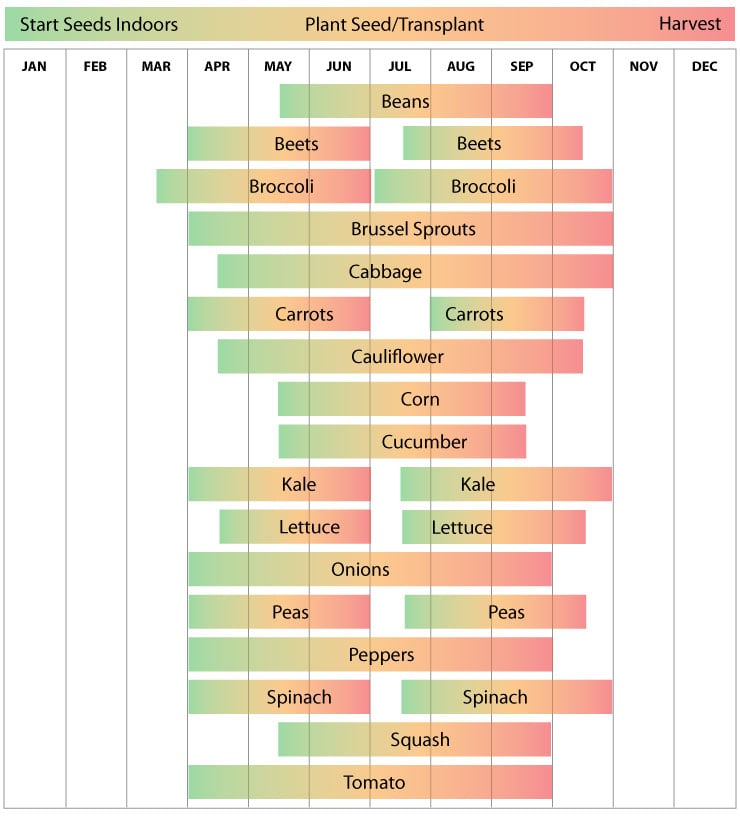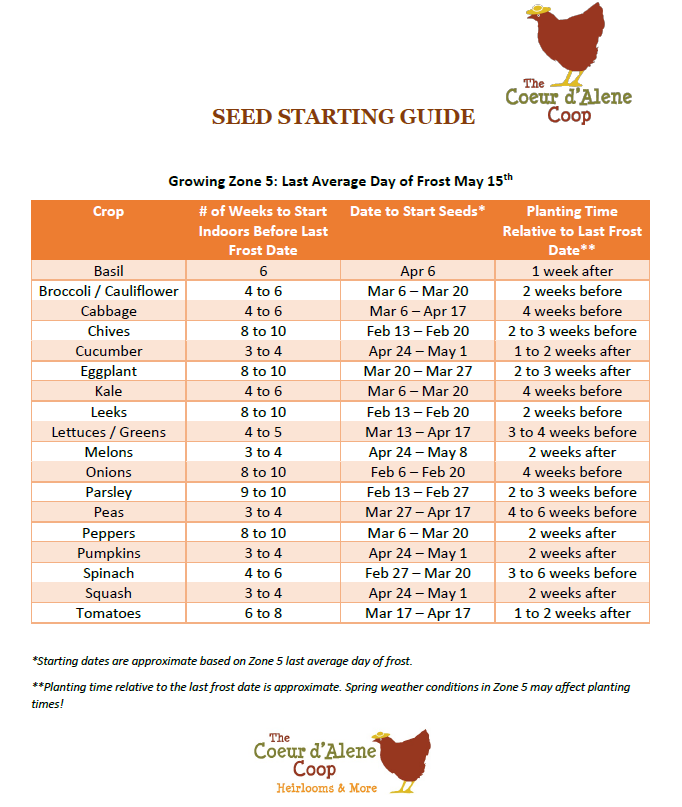The Zone 5 Seed Beginning Calendar: A Information To Success
The Zone 5 Seed Beginning Calendar: A Information to Success
Associated Articles: The Zone 5 Seed Beginning Calendar: A Information to Success
Introduction
With enthusiasm, let’s navigate via the intriguing subject associated to The Zone 5 Seed Beginning Calendar: A Information to Success. Let’s weave fascinating info and provide contemporary views to the readers.
Desk of Content material
The Zone 5 Seed Beginning Calendar: A Information to Success

Zone 5 gardeners face a singular problem: a shorter rising season than their hotter counterparts. To maximise yield and revel in a bountiful harvest, cautious planning and well timed seed beginning are important. This complete information offers an in depth Zone 5 seed beginning calendar, factoring within the nuances of this local weather and providing suggestions for achievement. Keep in mind that microclimates exist inside Zone 5, so these dates are pointers; regulate primarily based in your particular location and final frost date. All the time test your native climate forecast for potential late frosts.
Understanding Zone 5 and its Challenges:
Zone 5 experiences common annual minimal temperatures between -10°F and -20°F (-23°C and -29°C). The final frost date varies considerably throughout the zone, usually falling between mid-Could and early June, whereas the primary frost usually arrives in mid-to-late September. This leaves a comparatively brief rising season, emphasizing the significance of beginning seeds indoors effectively upfront. Chilly soil temperatures also can hinder germination and early development, even after the final frost.
Components to Take into account When Planning Your Seed Beginning Calendar:
- Your Final Frost Date: That is the essential piece of data. Seek the advice of your native agricultural extension workplace or on-line sources to find out the typical final frost date on your particular location inside Zone 5.
- Seed Germination Time: Every seed kind has a singular germination interval. Test the seed packet for steerage.
- Days to Maturity: This means the time from seed germination to reap. Take into account this rigorously to make sure your crops have sufficient time to mature earlier than the primary frost.
- Plant Hardiness: Select crops appropriate for Zone 5. Some crops are extra tolerant of cooler temperatures than others.
- Seed Beginning Provides: Collect your provides upfront: seed beginning combine, containers (seed trays, pots, and many others.), develop lights (important for Zone 5), labels, watering can, and a heat, sunny location.
The Zone 5 Seed Beginning Calendar:
This calendar offers estimated beginning dates for varied widespread greens, herbs, and flowers. Regulate these dates primarily based in your particular final frost date and the person seed’s germination time and days to maturity. Bear in mind to at all times test the seed packet for particular directions.
Early Starters (8-10 weeks earlier than final frost):
- Tomatoes: These heat-loving crops want a protracted rising season. Begin seeds indoors 8-10 weeks earlier than your final frost date. They’re sluggish to germinate, so endurance is essential.
- Peppers (candy and scorching): Much like tomatoes, peppers require heat and a protracted rising season. Begin seeds indoors 8-10 weeks earlier than your final frost.
- Eggplant: One other warm-weather crop, eggplant wants ample time to mature. Begin seeds 8-10 weeks earlier than your final frost.
- Basil: This standard herb is a warm-weather plant and advantages from a head begin indoors. Begin seeds 6-8 weeks earlier than your final frost.
- Celery: Celery requires a protracted rising season and advantages from beginning indoors. Begin seeds 8-10 weeks earlier than your final frost.
Mid-Season Starters (6-8 weeks earlier than final frost):
- Cucumbers: These vining crops are delicate to frost. Begin seeds indoors 6-8 weeks earlier than your final frost.
- Squash (summer time): Summer season squash varieties like zucchini and yellow squash want heat. Begin seeds indoors 6-8 weeks earlier than your final frost.
- Melons (cantaloupe, watermelon): These heat-loving crops want loads of time to mature. Begin seeds indoors 6-8 weeks earlier than your final frost.
- Beans (bush): Whereas bush beans might be instantly sown, beginning them indoors a couple of weeks earlier than the final frost can provide them a head begin.
- Lettuce (heat-tolerant varieties): Whereas many lettuces might be direct-sown, beginning heat-tolerant varieties indoors can prolong the harvest season.
Late Starters (4-6 weeks earlier than final frost):
- Beans (pole): Pole beans might be direct-sown, however beginning them indoors a couple of weeks early can present a barely earlier harvest.
- Summer season Squash (some varieties): Sure summer time squash varieties can tolerate barely cooler temperatures and might be began later.
- Zucchini: Much like different summer time squash, some varieties might be began later indoors.
- Flowers (many annuals): Many annual flowers might be began indoors 4-6 weeks earlier than your final frost. Test particular person plant necessities.
- Herbs (many annuals): Many annual herbs might be began later, resembling dill and cilantro.
Direct Sowing:
Some crops are finest direct-sown into the backyard after the final frost. This contains:
- Radishes: These quick-growing root greens thrive in cooler temperatures.
- Carrots: Carrots desire cooler soil temperatures.
- Spinach: This cool-season inexperienced tolerates cooler temperatures.
- Peas: Peas desire cooler temperatures and might be sown instantly into the backyard.
- Kale: This hardy inexperienced can tolerate cooler temperatures.
Hardening Off:
Earlier than transplanting seedlings outside, it is essential to harden them off. This course of step by step acclimates the seedlings to out of doors circumstances, stopping shock and bettering survival charges. Start hardening off 7-10 days earlier than transplanting. Regularly improve publicity to daylight and wind over a number of days.
Ideas for Success:
- Use a top quality seed beginning combine: Do not use backyard soil; it is too dense and might trigger damping off (fungal illness).
- Present satisfactory gentle: Seedlings want at the very least 12-16 hours of sunshine per day. Use develop lights if mandatory.
- Keep constant moisture: Hold the seed beginning combine persistently moist however not soggy.
- Guarantee correct air flow: Good air circulation prevents fungal ailments.
- Monitor for pests and ailments: Tackle any issues promptly.
- Skinny seedlings: Skinny seedlings to offer every plant sufficient house to develop.
- Transplant on the proper time: Transplant seedlings outside after the final frost and when soil temperatures are heat sufficient.
Conclusion:
Efficiently beginning seeds indoors in Zone 5 requires cautious planning and a spotlight to element. Through the use of this calendar as a suggestion and following the guidelines supplied, you possibly can considerably improve your probabilities of a bountiful harvest, regardless of the challenges of a shorter rising season. Bear in mind to adapt the calendar to your particular microclimate and at all times seek the advice of seed packets for particular directions. Glad gardening!








Closure
Thus, we hope this text has supplied precious insights into The Zone 5 Seed Beginning Calendar: A Information to Success. We hope you discover this text informative and helpful. See you in our subsequent article!
Leave a Reply